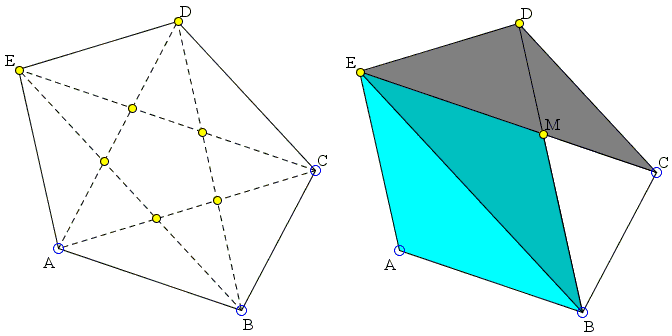Golden Ratio in an Irregular Pentagon
Here is a curious problem with a surprising solution [Prasolov, #4.9, p. 77, pp. 85-86]:
In a pentagon ABCDE the diagonals cut off triangles of area 1. Find the area of the pentagon.
(I thank Bui Quang Tuan for bringing this reference to my attention.)
References
|Activities| |Contact| |Front page| |Contents| |Geometry|
Copyright © 1996-2018 Alexander BogomolnyGolden Ratio in an Irregular Pentagon
In a pentagon ABCDE the diagonals cut off triangles of area 1. Find the area of the pentagon.
Pentagons with the given property have diagonals parallel to the sides. We prove this first and then show that the points of intersection of the diagonals divide each in the golden ratio.

First note that, since triangles ABC and ABE have the same area, the altitudes from C and E to AB must be equal so that CE||AB. The same holds for other pairs side/diagonal.
Let M be the point of intersection of BD and CE. Then ABME is a parallelogram and ΔABE = ΔMEB. Denote
Area(ABCDE) = Area(ABE) + Area(MEB) + Area(DEC) + x = 3 + x.
On the other hand,
| (*) | Area(BCM) / Area(CDM) = BM / DM = Area(MEB) / Area(DEM), |
Observe that, since BCDE is a trapezoid,
x / (1 - x) = 1 / x,
which gives an equation for x: x² + x - 1 = 0. It follows that
Area(ABCDE) = 3 + (√5 - 1)/2 = (√5 + 5)/2.
Bui Quang Tuan gave a practical Euclidean construction of such pentagons. He also observed that the pentagon formed by the diagonals is of the same kind. We may add that, if the sides of the pentagon are extended to form a star whose vertices constitute another such pentagon.
Finally, there is an additional construction of those pentagons.
Fibonacci Numbers
- Ceva's Theorem: A Matter of Appreciation
- When the Counting Gets Tough, the Tough Count on Mathematics
- I. Sharygin's Problem of Criminal Ministers
- Single Pile Games
- Take-Away Games
- Number 8 Is Interesting
- Curry's Paradox
- A Problem in Checker-Jumping
- Fibonacci's Quickies
- Fibonacci Numbers in Equilateral Triangle
- Binet's Formula by Inducion
- Binet's Formula via Generating Functions
- Generating Functions from Recurrences
- Cassini's Identity
- Fibonacci Idendtities with Matrices
- GCD of Fibonacci Numbers
- Binet's Formula with Cosines
- Lame's Theorem - First Application of Fibonacci Numbers
|Activities| |Contact| |Front page| |Contents| |Geometry|
Copyright © 1996-2018 Alexander Bogomolny71546476
